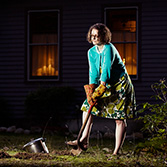Tete-a-tete Archives
An eclectic sampling of my award-winning humor columns. New columns can be read online at www.nashuatelegraph.com on the first Thursday of the month, with columns posted here later in the month.More in "Tete-a-tete"
- Tete-a-tete: Pop culture references lead to unexpected connections
- Tete-a-tete: "Handicapped accessible" doesn't really mean what people think it means
- Tete-a-tete: The ins and outs of the college moving experience
- Tete-a-tete: When dealing with cabin fever, this cat's on a roll
- Tete-a-tete: An artistic masterpiece 20 years in the making
- Tete-a-tete: Promp and circumstance: Modern-day prom prep
- Tete-a-tete: Blue Apron - a Pandora's box of weekly culinary adventures
- Tete-a-tete: Serve up a slice of family traditions, new or old
- Tete-a-tete: 'Family court' has a whole new meaning at our house
- Tete-a-tete: Drafted on the farm: Grandpa's war at home
- Tete-a-tete: With family, you have to give it the ol' college try
- Tete-a-tete: Walk a mile in my Boots: Viva la feline difference
- Tete-a-tete: Slacker movies offer unlikely heroes
- Tete-a-tete - Bag that theory: Purse contents aren't all that enlightening
- Tete-a-tete: Keeping up with the pace of modern-day elder care
- Tete-a-tete: Easter dinner reveals a shocking family secret
- Tete-a-tete: Time flies when you forget to change the clocks
- Tete-a-tete: Here in New Hampshire, we don't take voting 'for granite'
- Tete-a-tete: An Eagle takes flight in another family milestone
- Tete-a-tete: When choosing heirlooms, cross your Ts and dot your ... claims
- Tete-a-tete: Even the best-intentioned Christmas traditions can fail to take hold
- Tete-a-tete: How to enjoy a wedding, even if it's not your own
- Tete-a-tete: A tale of unintentional cat ownership
- Tete-a-tete: Admissions about the college admissions process
- Tete-a-tete: Avoiding car-tastrophe while purchasing a new vehicle
- Tete-a-tete: As American as apple pie: U.S. culture, through other eyes
- Tete-a-tete: The geek gene runs strong in our family
- Tete-a-tete: Grieving entertainment losses with a few simple steps
- Tete-a-tete: Parents, do not give your child the name equivalent of the April birthstone
- Tete-a-tete: Memento or clutter? Don't leave that decision to the historians
- Tete-a-tete: How Mom and Dad saved Christmas (and a hamster)
- Tete-a-tete: Having trouble keeping your New Year's resolutions? It could be "If You Give a Mouse a Cookie" Syndrome
- Tete-a-tete: When Christmas starts before Thanksgiving (a reflection on temporal discombobulation)
- Tete-a-tete: Sizing up a new family pet, or the difference between a cat and a hamster
- Tete-a-tete: When your worst fear comes true
- Tete-a-tete: Family game night can leave you drawing a blank
- Tete-a-tete: When you have a really good reason to skip class
- Tete-a-tete: The downside to the world's most flattering bridesmaid dress
- Tete-a-tete: Say it with flowers - just don't say where you got them
- Tete-a-tete: Shockingly true tales of my Herculean, heroic great-grandpa
- Tete-a-tete: For goodness 'sakes - generational namesakes can confuse
- Tete-a-tete: Confused by the weather? Signs spring has almost sprung
- Tete-a-tete: Seeking the Holy Grail of a universal bridesmaid dress
- Tete-a-tete: Love poetry gone bad, or why I'm still not allowed to use matches
- Tete-a-tete: A traveler's guide to the Big Apple
- Tete-a-tete: Feats of strength aren't just for Festivus festivities
- Tete-a-tete: Change comes from within - sometimes, literally
- Tete-a-tete: Car games: from punch-buggy to punching cell phone buttons
- Tete-a-tete: I mustache you a question about costume practicality
- Tete-a-tete: Functional furniture is making my family dysfunctional
- Tete-a-tete: Jungle Speed board game can bring out the beast in you
- Tete-a-tete: To call it a ‘mooving’ ride would be inaccurate
- Tete-a-tete: When saying ‘sweetheart’ just won’t do
- Tete-a-tete: Eat your heart out, Festivus: Stymchastynchula is here
- Tete-a-tete: Hoping Korean music can explode in the U.S. with a K-pop
- Tete-a-tete: Holidays, especially with Grandma, are always colorful
- Tete-a-tete: Sometimes, it's the grilled cheese that makes the memories
- Tete-a-tete: Still recovering from Dad's forays into home education
Tete-a-tete: When choosing heirlooms, cross your Ts and dot your … claims
Nothing spurs discussions about family history quite like a traditional holiday dinner. With family members young and old gathered round a table set with china, silverware and glassware that have been passed down through the generations, the story behind every important item is eventually shared – sometimes multiple times.
Younger family members may be tempted to block out the history of Great-Grandma’s cut-glass butter dish after hearing it year after year, but there comes a time when you realize you need to start listening very carefully. Older relatives start passing away, and suddenly you’re the one who has to remember the significance of the family tableware and other inherited items because eventually there won’t be anyone to jog your memory.
Not only that, you also find yourself in the awkward position of deciding what will be passed down to future generations and what may have to find a home elsewhere based on which items you express an interest in inheriting. Even with four children in our family, it’s impossible to keep everything.
As such, Mom has become very intentional about letting us know which table items are merely attractive and which ones have significance to our family. That oddly-shaped gravy boat is much more meaningful now that we know it was the designated vessel for Grandma’s homemade raisin sauce at every ham dinner. Though none of us kids may have room at present for a full set of Waterford goblets, we’re more inclined to stake our claim on one each now that we know Mom patiently collected them over a period of years, asking for a single goblet as a gift from her parents every Christmas.
Mom and Dad are in excellent health, so there’s no sense of urgency in regards to making those decisions. Over the past three years, however, Mom’s mother and Dad’s mother have both passed away, leaving items of varying family significance to each of us kids. Mom’s father, our only living grandparent, is steadily going through everything from furniture to photographs with Mom’s help, passing things along ahead of time and making notes about why they’re important.
As you can imagine, the future of our family heirlooms is rather at the forefront of our minds these days. Deciding who gets what can become a sticky situation, regardless of how big your family is. Hurt feelings can abound to such an extent that relatives who were once on good terms end up never speaking to each other again.
To avoid such issues, my siblings and I have developed a system of color-coded dot stickers, like you might see at a yard sale. Mine are red, Oldest Younger Brother’s are yellow, Youngest Brother’s are blue and Younger Sister’s are green. If there’s something one of us particularly wants, we stake our claim by putting our sticker on it. If more than one sibling wants the same item, we negotiate, offering dibs on other items in the house until we’re able to reach a satisfactory compromise.
The system currently exists in virtual form, as I don’t think our parents would be too pleased if we started sticking dots all over the furniture, dishes and various knickknacks. We do, however, announce our interest in inheriting something by telling the family we’d like to put our dot on that.
I, for example, have my dot on a wooden blanket cabinet and an assortment of cordial glasses. Youngest Brother has his dot on the sterling silver flatware, the piano, a painting of the ocean done by our great-great-grandmother, and two of Grandpa’s tool cabinets, stocked with tools from previous generations. Oldest Younger Brother has his dot on a couple of glass-fronted, cabinet-style bookcases.
This practice has led to some rather preemptive dotting. Not that long ago, Mom purchased a lovely new lamp. As she was removing the lamp from its box, 16-year-old Younger Sister’s eyes lit up. “I’m totally putting a green dot on that,” she exclaimed.
Mom responded by complimenting Younger Sister on her excellent taste and asking if she wanted any of the furniture that coordinated with the lamp. Mom is passionate about making sure each of us kids get what we want from the family possessions (along with any corresponding pieces) as well as making sure we understand why those things are important.
And it really does make a difference to know what’s important and what isn’t. For example, Mom prefers to store home-brewed iced tea in glass containers rather than plastic ones, so she has saved a number of glass bottles and jars for this purpose. And it is entirely a matter of her preference; there’s no family or historical significance attached to them. Knowing this saves us the agony of deciding what to do with them in the future. They can be recycled without guilt and without shame, unless one of us wants to hold onto them for the associated iced tea memories.
There comes a point in every family’s holiday celebrations when the past and the future collide. Instead of simply listening to the stories behind the holiday tableware, you become the person who will preserve those items and their stories for the generations to come – or who will send those items to estate sales or secondhand stores where they’ll become part of other families and other stories.
So listen carefully. Choose carefully. And have your dots at the ready – but not literally. It doesn’t matter how old you are; you can still be grounded for prematurely sticking dots all over your mother’s teapot.
– Teresa Santoski
Originally published Jan. 7, 2016
Browse the compendium
Compendium (noun): a summary or abridgment.
Click the icons to the right to check out a sampling of my work.




